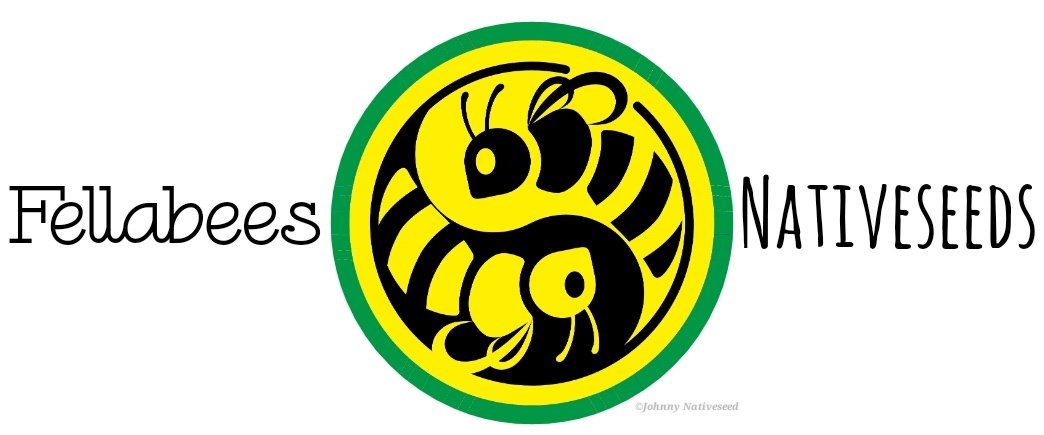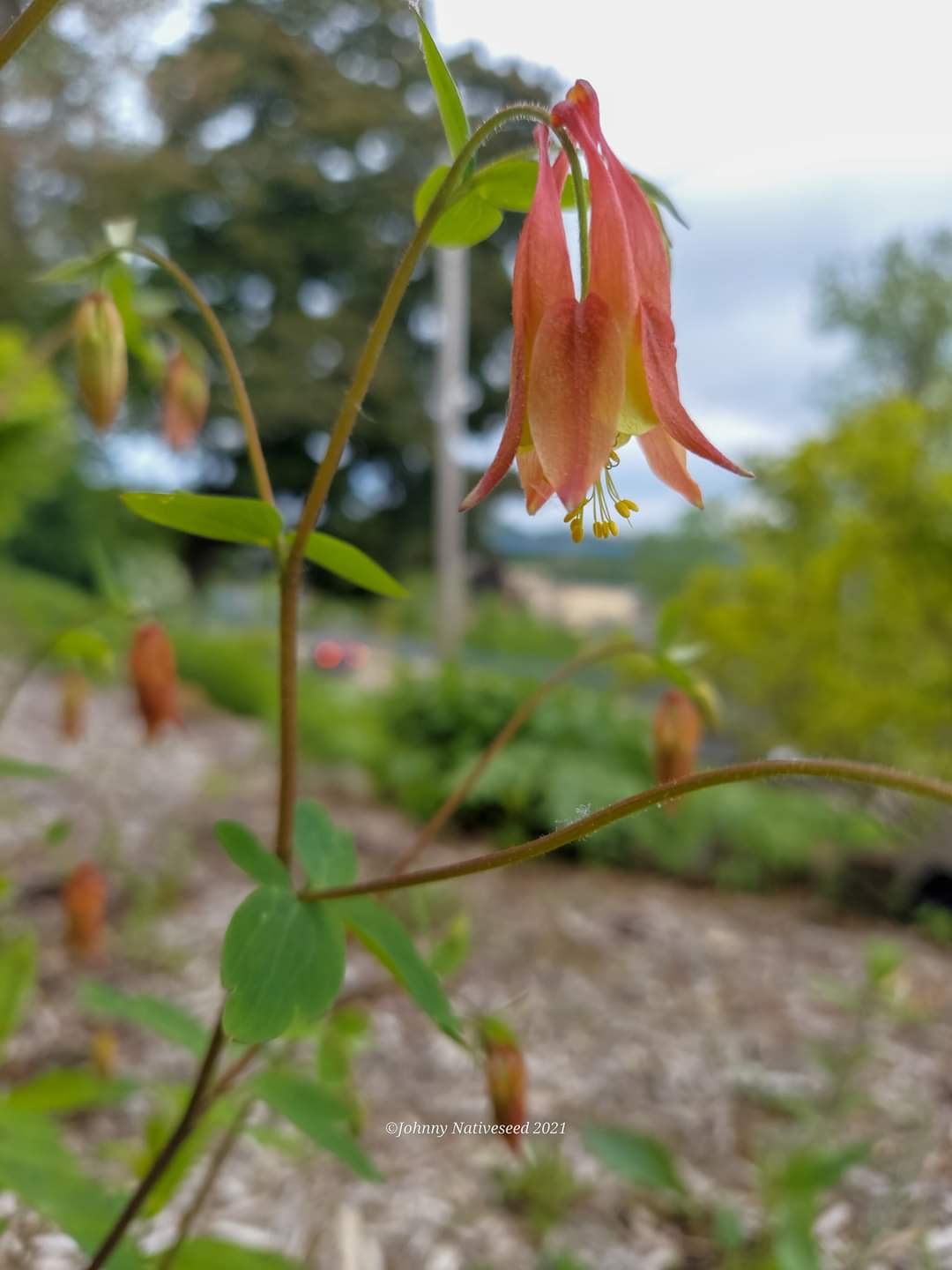 Image 1 of 8
Image 1 of 8

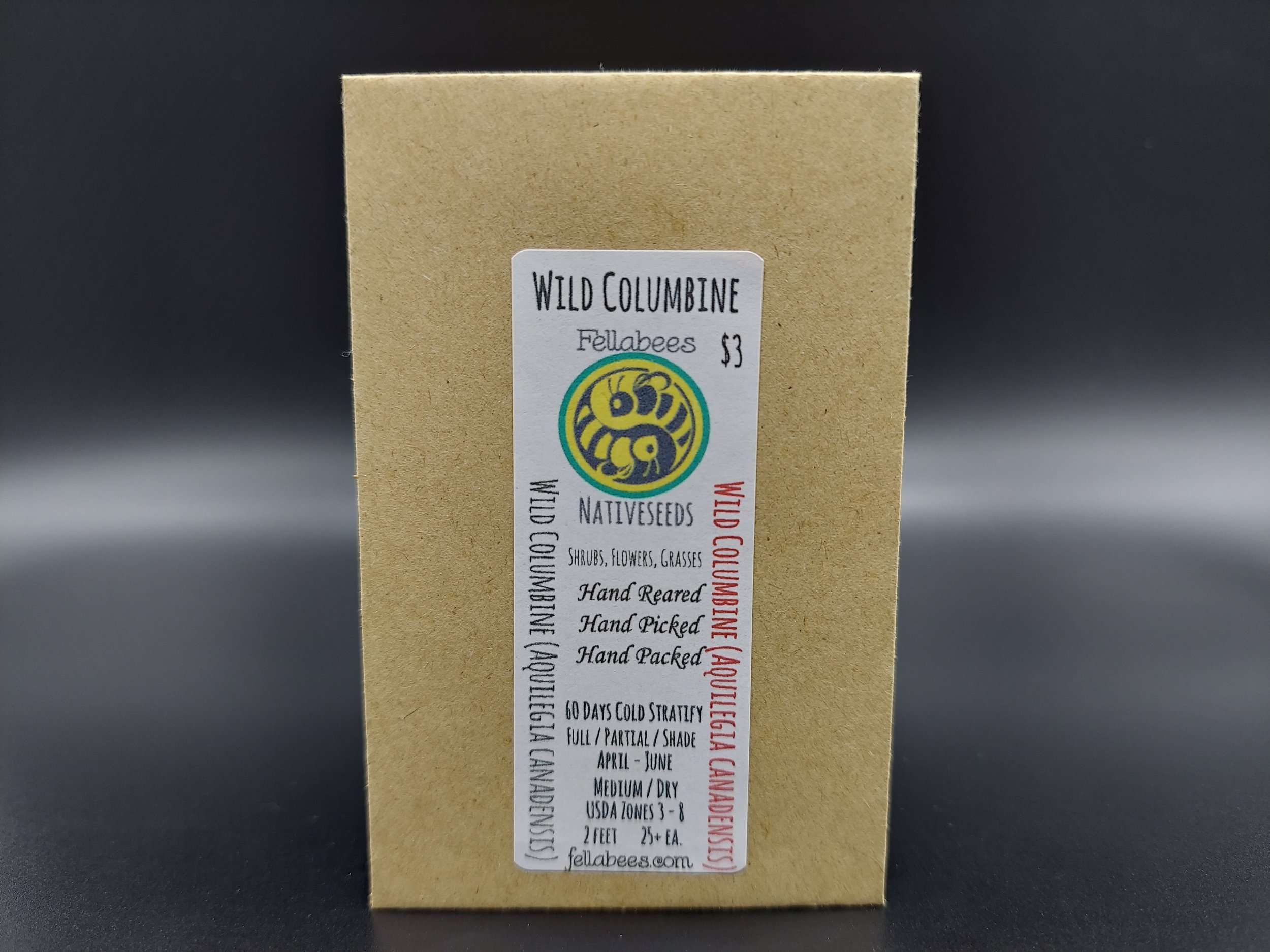 Image 2 of 8
Image 2 of 8

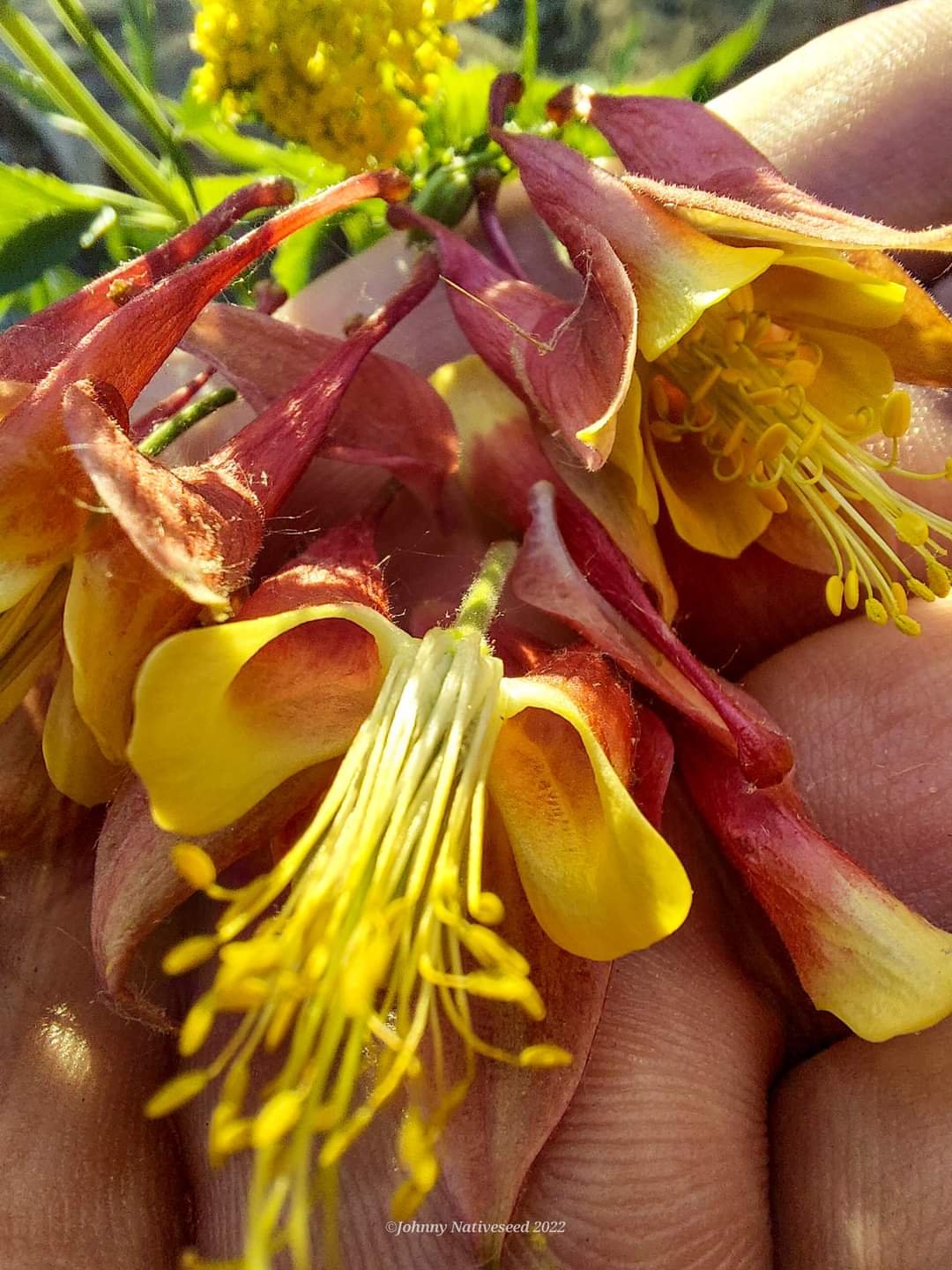 Image 3 of 8
Image 3 of 8

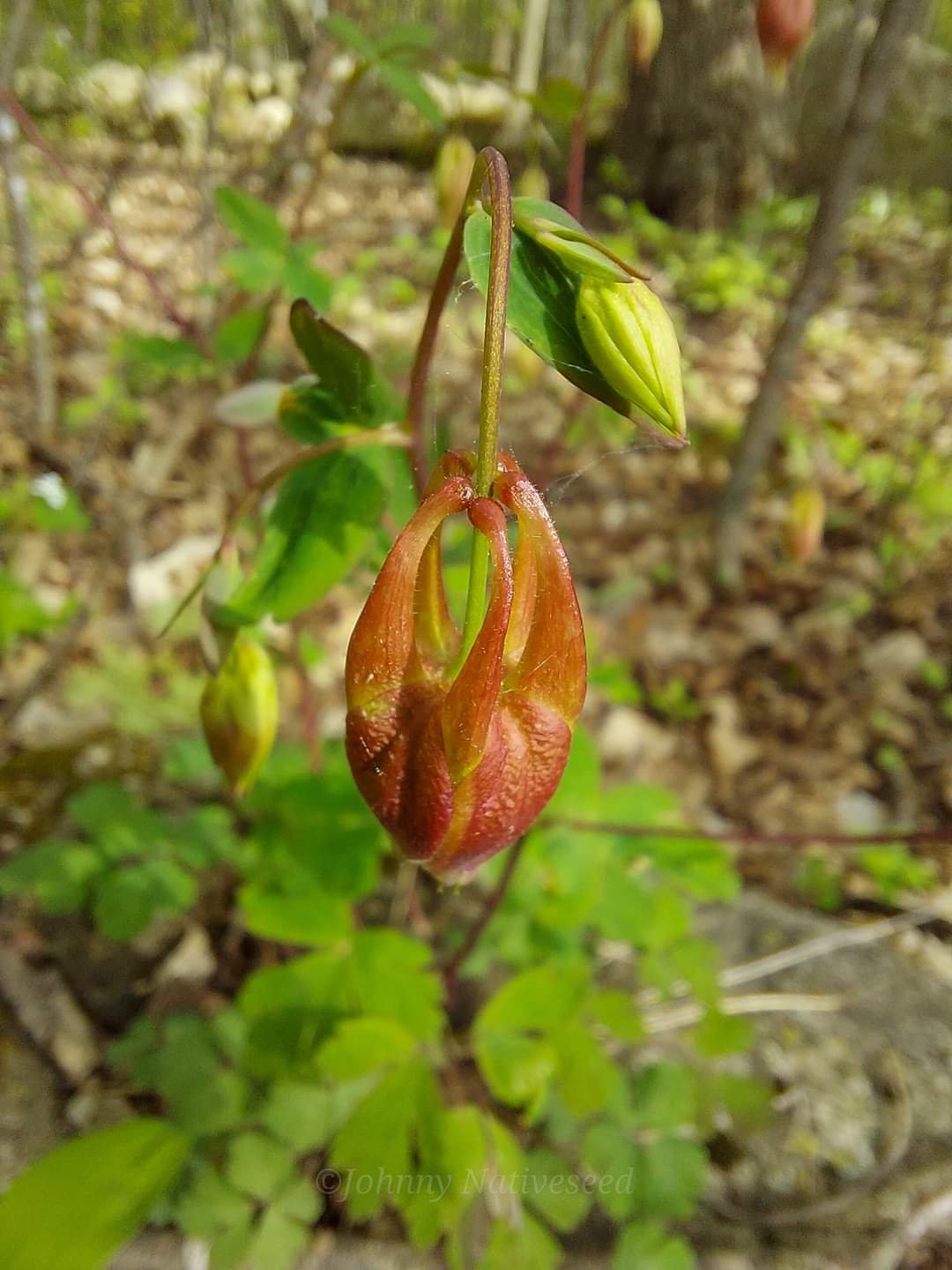 Image 4 of 8
Image 4 of 8

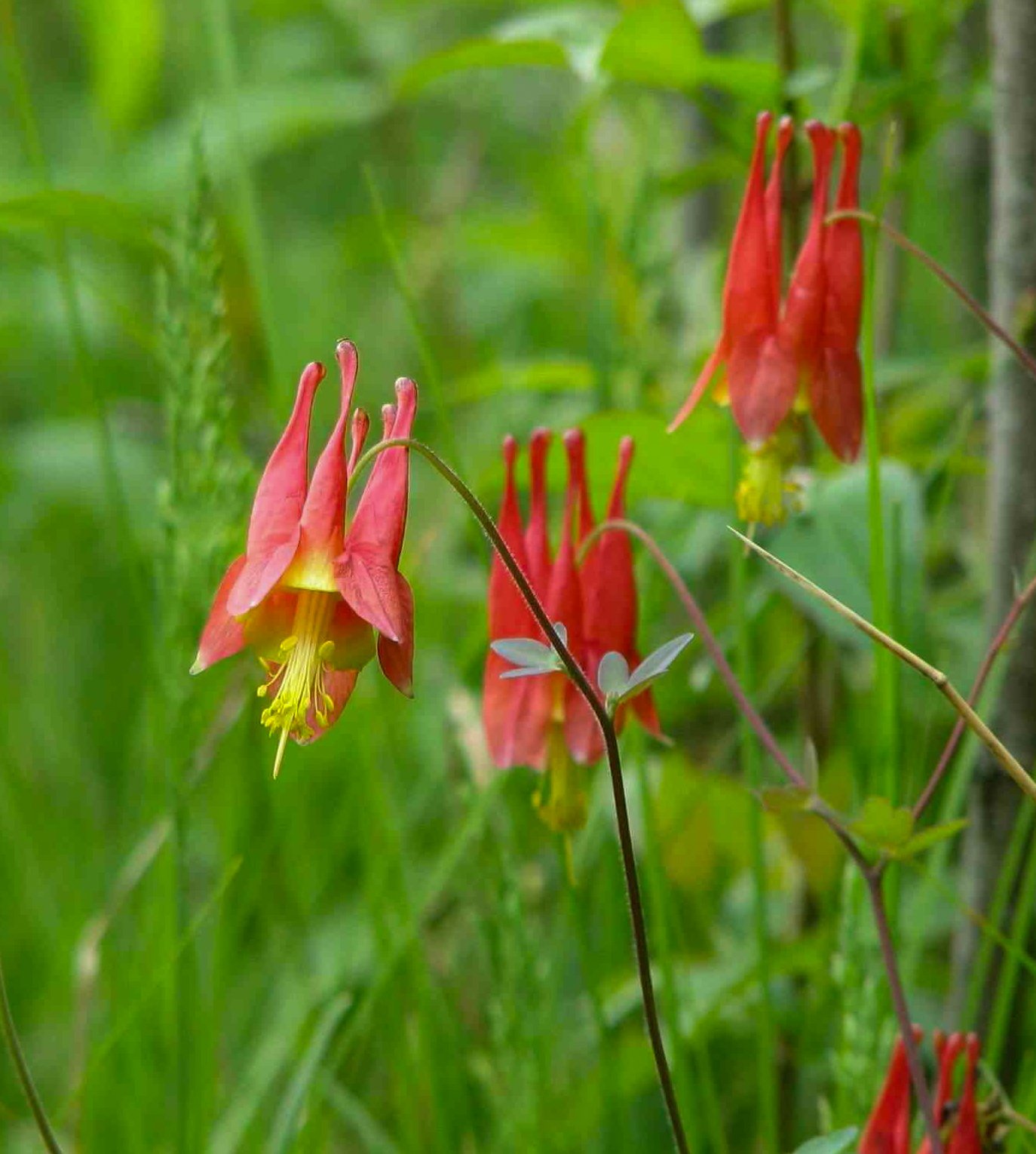 Image 5 of 8
Image 5 of 8

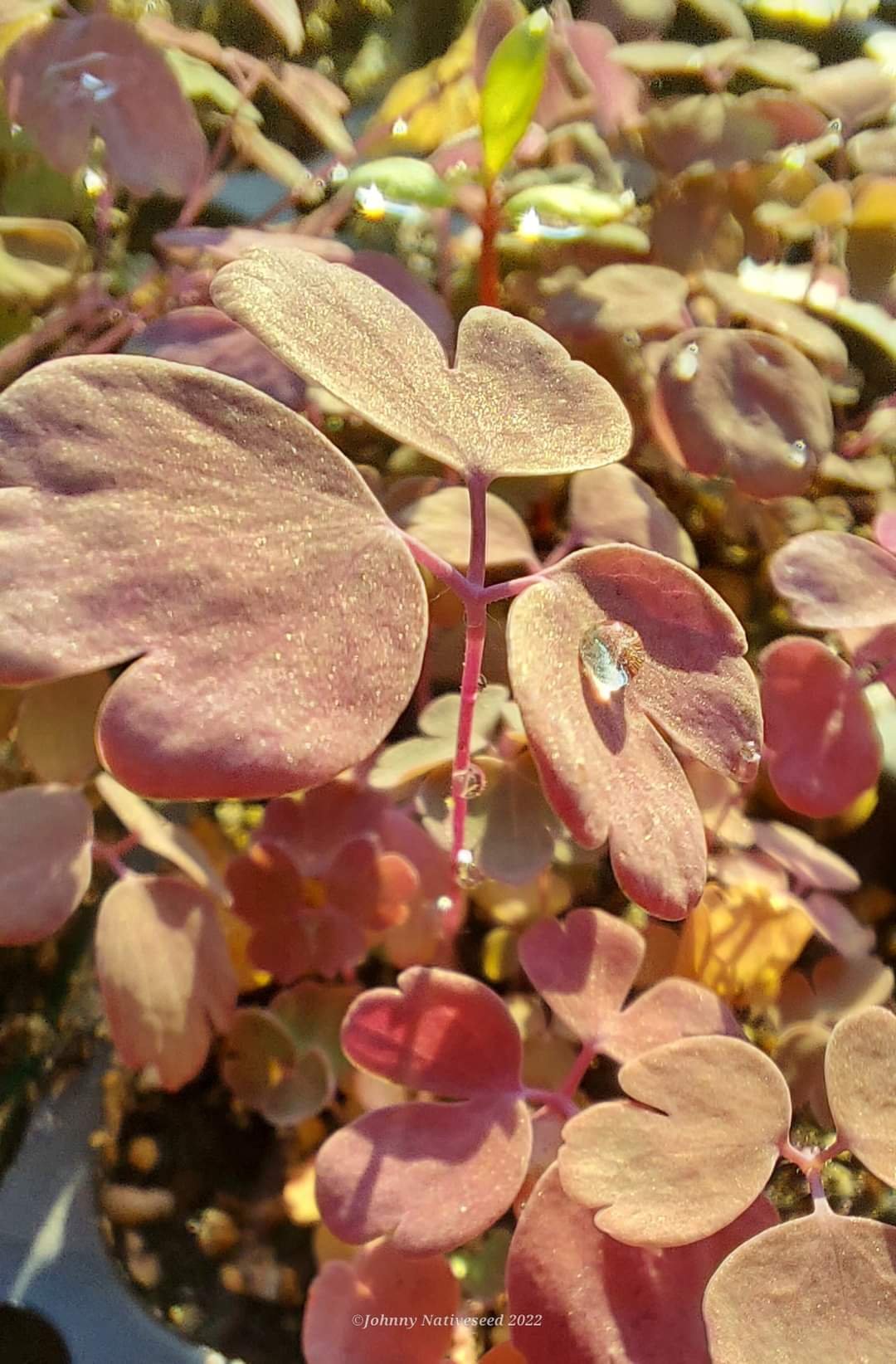 Image 6 of 8
Image 6 of 8

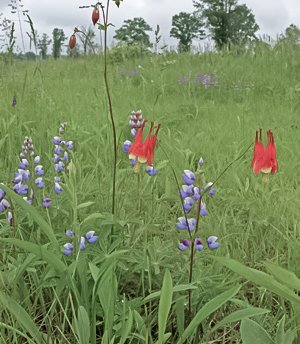 Image 7 of 8
Image 7 of 8

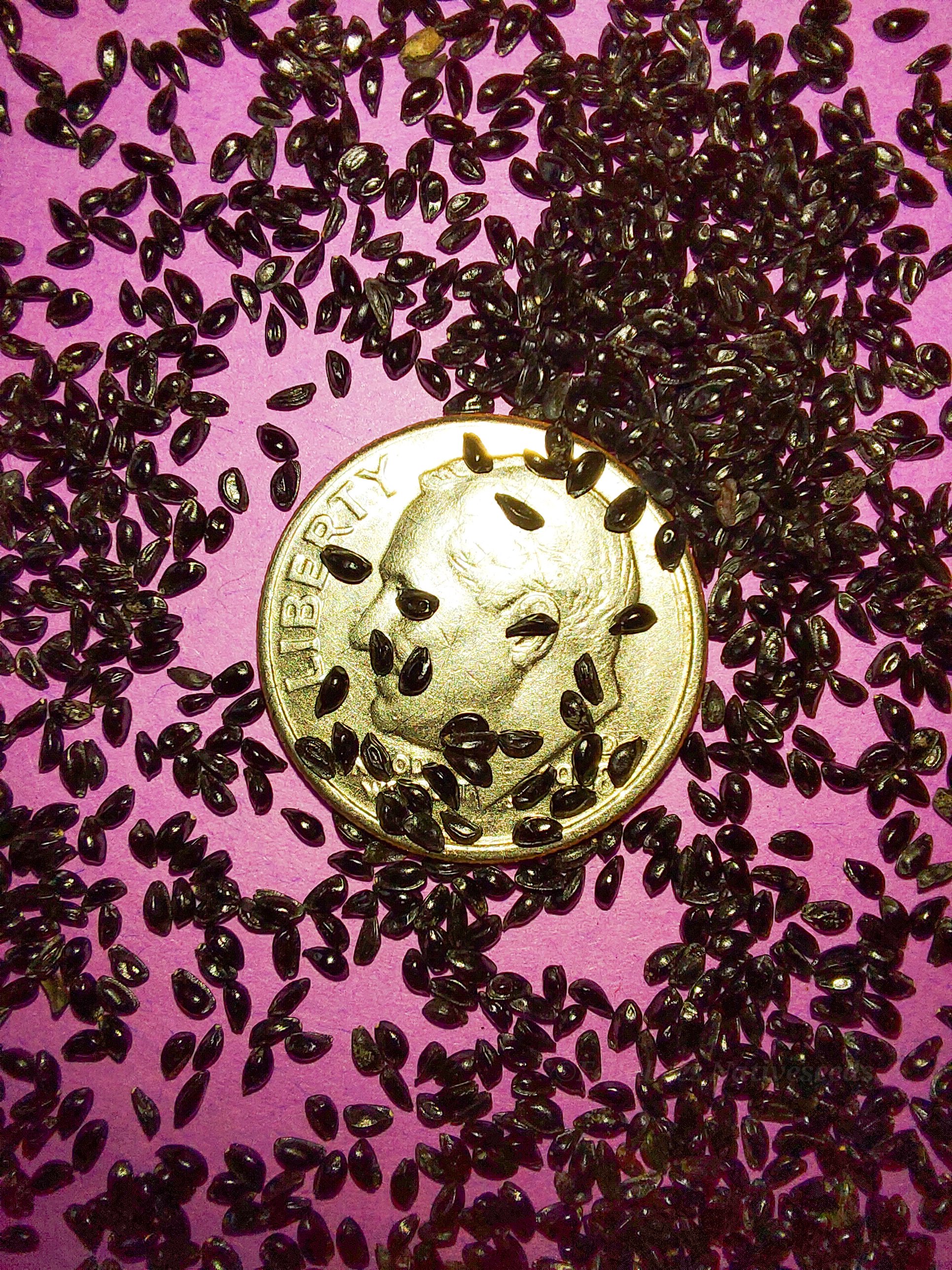 Image 8 of 8
Image 8 of 8









Wild Columbine (Aquilegia canadensis)
Wild Columbine (Aquilegia canadensis)
Aquilegia canadensis, or more commonly known as Wild Columbine, Canadian or Canada Columbine, or Eastern Red Columbine, is a species of flowering plant in the buttercup family, Ranunculaceae.
It is an herbaceous perennial native flowering plant that ranges from dense dappled woodland to steep rocky slopes in eastern North America.
It is highly sought after for its bold bell-shaped red and yellow flowers by many pollinators such as early arriving hummingbirds, many bees including Mining bees, Bumblebees, and Leafcutter Bees.
Wild Columbine is the larval host plant for the enigmatic spread wing Skipper Butterfly commonly known as the Columbine Duskywing Butterfly which is considered to be critically imperiled and even extirpated (locally extinct) in several states in its native range.
Aquilegia canadensis is a highly decorative plant that unlike many natives, is easily propagated from seed, and will bloom the second year after sowing. It is a very long lived perrenial of the garden or on the prairie.
It will grow well in shade, but will also thrive in sun with proper moisture.
Indigenous peoples used various parts of Wild Columbine in herbal remedies for ailments such as headache, sore throat, fever, rash caused by poison ivy, stomatitis, kidney and urinary problems, and heart problems. It is rumored that Indigenous men also rubbed the crushed seeds of Wild Columbine on their hands as a love charm, and aphrodisiac.
Wild columbine contains a natural compound called cyanogenic glycoside.
What is a cyanogenic glycoside?
(Plants that make cyanogenic glycosides store them in the vacuole, however, if the plant is attacked, they release this compound which becomes activated by an enzyme in the cytoplasm. These work to remove the sugar part of the compounds molecule, allowing the cyanohydrin structure to collapse and then suddenly release toxic hydrogen cyanide.
The genius of storing the compounds in their inactive forms in the vacuole prevents them from damaging the plant under normal conditions.
Utilizing this plant may go a long way to helping to deter herbivores such as deer and rabbits, but pressure by them still occurs.
These compounds may also serve to control germination, bud formation, carbon and nitrogen transport, and may possibly even act as antioxidants.
The production of cyanogenic glycosides is an evolutionarily conserved function, appearing in species as old as ferns and as recent as angiosperms.)
When predated on by herbivores Wild Columbine releases these Compounds to produce poisonous hydrogen cyanide, which if consumed in high volume can cause upset, and limit herbivory pressure.
What is Hydrogen Cyanide?
(Hydrogen cyanide, sometimes called prussic acid, is a chemical compound with the chemical formula HCN.
It is a colorless, extremely poisonous, and flammable liquid that boils slightly above room temperature, at 78.1 °F
HCN is produced on an industrial scale and is a highly valued precursor to many chemical compounds ranging from polymers to pharmaceuticals.
Wild Columbine is an amazing plant and when all of its traits are fully considered it is still just one piece of the dynamic synergy that plays out in a diverse native landscape.
This plant is considered present but rare in several counties of the states of Delaware, Mississippi, and Alabama.
Plant Details
USDA Zones: 3-8
Germination Needs: 60 Days Cold Moist Stratification. While it can be started artificially indoors it does seem to do better being planted outdoors in fall. If the stratification process is mimicked artificially it will still do quite well in trays before transplanting outdoors.
Life Cycle: Perennial
Sun Exposure: Full Sun, Partial, Shade
Soil Moisture: Medium, Medium-Dry, Dry
Plant Spacing: 10-17 inches
Height: 2 feet
Bloom time: April, May, June
Bloom Color: Red
Advantages :
Pollinator Favorite: butterflies, moths, bees, wasps, beetles
Bird Favorite: seeds, insects, fruit, nectar, nesting, perchs.
Deer Resistant: Yes
Excellent in the home landscape!
Native to: Wisconsin, Minnesota, Iowa, Illinois, Michigan, Indiana, Ohio, Pennsylvania, New York, Vermont, New Hampshire, Maine, Massachusetts, Rhode Island, Connecticut, Delaware, Maryland, New Jersey, West Virginia, Virginia, Kentucky, Tennessee, North Carolina, South Carolina, Georgia, Florida, Alabama, Georgia, Mississippi, Arkansas, Missouri, Texas, Oklahoma, Kansas, Nebraska, South Dakota, and North Dakota.
.
.
Packet quantities:
We pride ourselves on ethical, hands on, ecological management, using no mechanical or chemical methods whatsoever.
All of our native seed is hand reared, hand picked, and hand packed from native prairies under our exclusive management, never breaking chain of custody from the field until it is sent to you. Each packet is hand prepared for shipment by us, directly.
Small seed species will contain greater than 20-25 seed
Large seed species will contain greater than 10-15 seed
It is our mission to spread the wealth of native plant and pollinator ecological sustainability, and educate back yard gardeners as well as corporate and government entities in how to germinate, grow, and benefit from native synergies.
Thank you for your support, it is because of you, that we can grow together to do, what we do.🐛🦋🐝🐞🌾🌱🌼🧡
Wild Columbine (Aquilegia canadensis)
Aquilegia canadensis, or more commonly known as Wild Columbine, Canadian or Canada Columbine, or Eastern Red Columbine, is a species of flowering plant in the buttercup family, Ranunculaceae.
It is an herbaceous perennial native flowering plant that ranges from dense dappled woodland to steep rocky slopes in eastern North America.
It is highly sought after for its bold bell-shaped red and yellow flowers by many pollinators such as early arriving hummingbirds, many bees including Mining bees, Bumblebees, and Leafcutter Bees.
Wild Columbine is the larval host plant for the enigmatic spread wing Skipper Butterfly commonly known as the Columbine Duskywing Butterfly which is considered to be critically imperiled and even extirpated (locally extinct) in several states in its native range.
Aquilegia canadensis is a highly decorative plant that unlike many natives, is easily propagated from seed, and will bloom the second year after sowing. It is a very long lived perrenial of the garden or on the prairie.
It will grow well in shade, but will also thrive in sun with proper moisture.
Indigenous peoples used various parts of Wild Columbine in herbal remedies for ailments such as headache, sore throat, fever, rash caused by poison ivy, stomatitis, kidney and urinary problems, and heart problems. It is rumored that Indigenous men also rubbed the crushed seeds of Wild Columbine on their hands as a love charm, and aphrodisiac.
Wild columbine contains a natural compound called cyanogenic glycoside.
What is a cyanogenic glycoside?
(Plants that make cyanogenic glycosides store them in the vacuole, however, if the plant is attacked, they release this compound which becomes activated by an enzyme in the cytoplasm. These work to remove the sugar part of the compounds molecule, allowing the cyanohydrin structure to collapse and then suddenly release toxic hydrogen cyanide.
The genius of storing the compounds in their inactive forms in the vacuole prevents them from damaging the plant under normal conditions.
Utilizing this plant may go a long way to helping to deter herbivores such as deer and rabbits, but pressure by them still occurs.
These compounds may also serve to control germination, bud formation, carbon and nitrogen transport, and may possibly even act as antioxidants.
The production of cyanogenic glycosides is an evolutionarily conserved function, appearing in species as old as ferns and as recent as angiosperms.)
When predated on by herbivores Wild Columbine releases these Compounds to produce poisonous hydrogen cyanide, which if consumed in high volume can cause upset, and limit herbivory pressure.
What is Hydrogen Cyanide?
(Hydrogen cyanide, sometimes called prussic acid, is a chemical compound with the chemical formula HCN.
It is a colorless, extremely poisonous, and flammable liquid that boils slightly above room temperature, at 78.1 °F
HCN is produced on an industrial scale and is a highly valued precursor to many chemical compounds ranging from polymers to pharmaceuticals.
Wild Columbine is an amazing plant and when all of its traits are fully considered it is still just one piece of the dynamic synergy that plays out in a diverse native landscape.
This plant is considered present but rare in several counties of the states of Delaware, Mississippi, and Alabama.
Plant Details
USDA Zones: 3-8
Germination Needs: 60 Days Cold Moist Stratification. While it can be started artificially indoors it does seem to do better being planted outdoors in fall. If the stratification process is mimicked artificially it will still do quite well in trays before transplanting outdoors.
Life Cycle: Perennial
Sun Exposure: Full Sun, Partial, Shade
Soil Moisture: Medium, Medium-Dry, Dry
Plant Spacing: 10-17 inches
Height: 2 feet
Bloom time: April, May, June
Bloom Color: Red
Advantages :
Pollinator Favorite: butterflies, moths, bees, wasps, beetles
Bird Favorite: seeds, insects, fruit, nectar, nesting, perchs.
Deer Resistant: Yes
Excellent in the home landscape!
Native to: Wisconsin, Minnesota, Iowa, Illinois, Michigan, Indiana, Ohio, Pennsylvania, New York, Vermont, New Hampshire, Maine, Massachusetts, Rhode Island, Connecticut, Delaware, Maryland, New Jersey, West Virginia, Virginia, Kentucky, Tennessee, North Carolina, South Carolina, Georgia, Florida, Alabama, Georgia, Mississippi, Arkansas, Missouri, Texas, Oklahoma, Kansas, Nebraska, South Dakota, and North Dakota.
.
.
Packet quantities:
We pride ourselves on ethical, hands on, ecological management, using no mechanical or chemical methods whatsoever.
All of our native seed is hand reared, hand picked, and hand packed from native prairies under our exclusive management, never breaking chain of custody from the field until it is sent to you. Each packet is hand prepared for shipment by us, directly.
Small seed species will contain greater than 20-25 seed
Large seed species will contain greater than 10-15 seed
It is our mission to spread the wealth of native plant and pollinator ecological sustainability, and educate back yard gardeners as well as corporate and government entities in how to germinate, grow, and benefit from native synergies.
Thank you for your support, it is because of you, that we can grow together to do, what we do.🐛🦋🐝🐞🌾🌱🌼🧡
Wild Columbine (Aquilegia canadensis)
Aquilegia canadensis, or more commonly known as Wild Columbine, Canadian or Canada Columbine, or Eastern Red Columbine, is a species of flowering plant in the buttercup family, Ranunculaceae.
It is an herbaceous perennial native flowering plant that ranges from dense dappled woodland to steep rocky slopes in eastern North America.
It is highly sought after for its bold bell-shaped red and yellow flowers by many pollinators such as early arriving hummingbirds, many bees including Mining bees, Bumblebees, and Leafcutter Bees.
Wild Columbine is the larval host plant for the enigmatic spread wing Skipper Butterfly commonly known as the Columbine Duskywing Butterfly which is considered to be critically imperiled and even extirpated (locally extinct) in several states in its native range.
Aquilegia canadensis is a highly decorative plant that unlike many natives, is easily propagated from seed, and will bloom the second year after sowing. It is a very long lived perrenial of the garden or on the prairie.
It will grow well in shade, but will also thrive in sun with proper moisture.
Indigenous peoples used various parts of Wild Columbine in herbal remedies for ailments such as headache, sore throat, fever, rash caused by poison ivy, stomatitis, kidney and urinary problems, and heart problems. It is rumored that Indigenous men also rubbed the crushed seeds of Wild Columbine on their hands as a love charm, and aphrodisiac.
Wild columbine contains a natural compound called cyanogenic glycoside.
What is a cyanogenic glycoside?
(Plants that make cyanogenic glycosides store them in the vacuole, however, if the plant is attacked, they release this compound which becomes activated by an enzyme in the cytoplasm. These work to remove the sugar part of the compounds molecule, allowing the cyanohydrin structure to collapse and then suddenly release toxic hydrogen cyanide.
The genius of storing the compounds in their inactive forms in the vacuole prevents them from damaging the plant under normal conditions.
Utilizing this plant may go a long way to helping to deter herbivores such as deer and rabbits, but pressure by them still occurs.
These compounds may also serve to control germination, bud formation, carbon and nitrogen transport, and may possibly even act as antioxidants.
The production of cyanogenic glycosides is an evolutionarily conserved function, appearing in species as old as ferns and as recent as angiosperms.)
When predated on by herbivores Wild Columbine releases these Compounds to produce poisonous hydrogen cyanide, which if consumed in high volume can cause upset, and limit herbivory pressure.
What is Hydrogen Cyanide?
(Hydrogen cyanide, sometimes called prussic acid, is a chemical compound with the chemical formula HCN.
It is a colorless, extremely poisonous, and flammable liquid that boils slightly above room temperature, at 78.1 °F
HCN is produced on an industrial scale and is a highly valued precursor to many chemical compounds ranging from polymers to pharmaceuticals.
Wild Columbine is an amazing plant and when all of its traits are fully considered it is still just one piece of the dynamic synergy that plays out in a diverse native landscape.
This plant is considered present but rare in several counties of the states of Delaware, Mississippi, and Alabama.
Plant Details
USDA Zones: 3-8
Germination Needs: 60 Days Cold Moist Stratification. While it can be started artificially indoors it does seem to do better being planted outdoors in fall. If the stratification process is mimicked artificially it will still do quite well in trays before transplanting outdoors.
Life Cycle: Perennial
Sun Exposure: Full Sun, Partial, Shade
Soil Moisture: Medium, Medium-Dry, Dry
Plant Spacing: 10-17 inches
Height: 2 feet
Bloom time: April, May, June
Bloom Color: Red
Advantages :
Pollinator Favorite: butterflies, moths, bees, wasps, beetles
Bird Favorite: seeds, insects, fruit, nectar, nesting, perchs.
Deer Resistant: Yes
Excellent in the home landscape!
Native to: Wisconsin, Minnesota, Iowa, Illinois, Michigan, Indiana, Ohio, Pennsylvania, New York, Vermont, New Hampshire, Maine, Massachusetts, Rhode Island, Connecticut, Delaware, Maryland, New Jersey, West Virginia, Virginia, Kentucky, Tennessee, North Carolina, South Carolina, Georgia, Florida, Alabama, Georgia, Mississippi, Arkansas, Missouri, Texas, Oklahoma, Kansas, Nebraska, South Dakota, and North Dakota.
.
.
Packet quantities:
We pride ourselves on ethical, hands on, ecological management, using no mechanical or chemical methods whatsoever.
All of our native seed is hand reared, hand picked, and hand packed from native prairies under our exclusive management, never breaking chain of custody from the field until it is sent to you. Each packet is hand prepared for shipment by us, directly.
Small seed species will contain greater than 20-25 seed
Large seed species will contain greater than 10-15 seed
It is our mission to spread the wealth of native plant and pollinator ecological sustainability, and educate back yard gardeners as well as corporate and government entities in how to germinate, grow, and benefit from native synergies.
Thank you for your support, it is because of you, that we can grow together to do, what we do.🐛🦋🐝🐞🌾🌱🌼🧡
